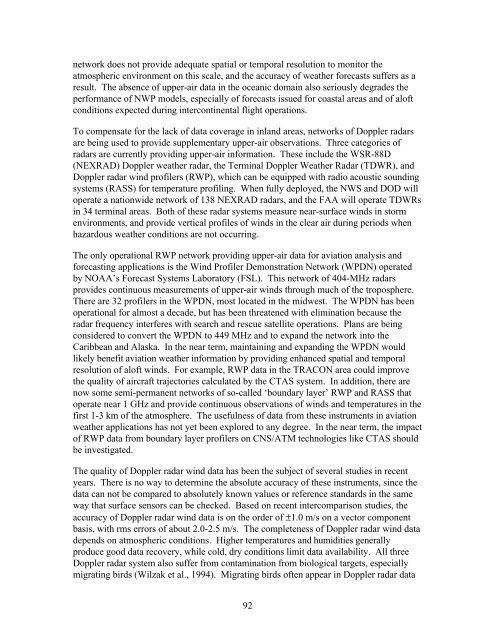Air Traffic Management Concept Baseline Definition - The Boeing ...
Air Traffic Management Concept Baseline Definition - The Boeing ...
Air Traffic Management Concept Baseline Definition - The Boeing ...
You also want an ePaper? Increase the reach of your titles
YUMPU automatically turns print PDFs into web optimized ePapers that Google loves.
network does not provide adequate spatial or temporal resolution to monitor the<br />
atmospheric environment on this scale, and the accuracy of weather forecasts suffers as a<br />
result. <strong>The</strong> absence of upper-air data in the oceanic domain also seriously degrades the<br />
performance of NWP models, especially of forecasts issued for coastal areas and of aloft<br />
conditions expected during intercontinental flight operations.<br />
To compensate for the lack of data coverage in inland areas, networks of Doppler radars<br />
are being used to provide supplementary upper-air observations. Three categories of<br />
radars are currently providing upper-air information. <strong>The</strong>se include the WSR-88D<br />
(NEXRAD) Doppler weather radar, the Terminal Doppler Weather Radar (TDWR), and<br />
Doppler radar wind profilers (RWP), which can be equipped with radio acoustic sounding<br />
systems (RASS) for temperature profiling. When fully deployed, the NWS and DOD will<br />
operate a nationwide network of 138 NEXRAD radars, and the FAA will operate TDWRs<br />
in 34 terminal areas. Both of these radar systems measure near-surface winds in storm<br />
environments, and provide vertical profiles of winds in the clear air during periods when<br />
hazardous weather conditions are not occurring.<br />
<strong>The</strong> only operational RWP network providing upper-air data for aviation analysis and<br />
forecasting applications is the Wind Profiler Demonstration Network (WPDN) operated<br />
by NOAA’s Forecast Systems Laboratory (FSL). This network of 404-MHz radars<br />
provides continuous measurements of upper-air winds through much of the troposphere.<br />
<strong>The</strong>re are 32 profilers in the WPDN, most located in the midwest. <strong>The</strong> WPDN has been<br />
operational for almost a decade, but has been threatened with elimination because the<br />
radar frequency interferes with search and rescue satellite operations. Plans are being<br />
considered to convert the WPDN to 449 MHz and to expand the network into the<br />
Caribbean and Alaska. In the near term, maintaining and expanding the WPDN would<br />
likely benefit aviation weather information by providing enhanced spatial and temporal<br />
resolution of aloft winds. For example, RWP data in the TRACON area could improve<br />
the quality of aircraft trajectories calculated by the CTAS system. In addition, there are<br />
now some semi-permanent networks of so-called ‘boundary layer’ RWP and RASS that<br />
operate near 1 GHz and provide continuous observations of winds and temperatures in the<br />
first 1-3 km of the atmosphere. <strong>The</strong> usefulness of data from these instruments in aviation<br />
weather applications has not yet been explored to any degree. In the near term, the impact<br />
of RWP data from boundary layer profilers on CNS/ATM technologies like CTAS should<br />
be investigated.<br />
<strong>The</strong> quality of Doppler radar wind data has been the subject of several studies in recent<br />
years. <strong>The</strong>re is no way to determine the absolute accuracy of these instruments, since the<br />
data can not be compared to absolutely known values or reference standards in the same<br />
way that surface sensors can be checked. Based on recent intercomparison studies, the<br />
accuracy of Doppler radar wind data is on the order of ±1.0 m/s on a vector component<br />
basis, with rms errors of about 2.0-2.5 m/s. <strong>The</strong> completeness of Doppler radar wind data<br />
depends on atmospheric conditions. Higher temperatures and humidities generally<br />
produce good data recovery, while cold, dry conditions limit data availability. All three<br />
Doppler radar system also suffer from contamination from biological targets, especially<br />
migrating birds (Wilzak et al., 1994). Migrating birds often appear in Doppler radar data<br />
92
















